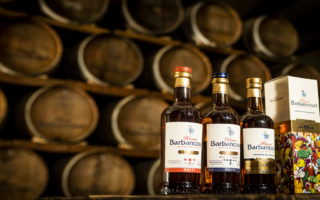Recipe: crêpe Suzette
Learn how to make a liqueur-soaked pancake that is popular during Chandeleur and Lent
Trace the origins of many a classic French recipe, and the story will either lead you back to the great chef Auguste Escoffier or to a kitchen accident. In the case of crêpes Suzette, we will never quite know which one was behind this particular stroke of genius.
Some sources credit Henri Charpentier, a young disciple of Escoffier, with the happy mistake of setting fire to a pan of crêpes in orange sauce before serving them to the future King Edward VII at the Café de Paris in Monaco in 1896. When the Prince of Wales praised the dish, Charpentier apparently offered to name it after him. Gallantly, the prince refused and gave it the name of his beautiful companion that day (or perhaps that of a stranger at a neighbouring table, depending on the version of the story).
Appealing as this tale is, the pragmatic Larousse Gastronomique dismisses it as a false claim by Escoffier’s underling, who later went on to popularize this dessert as Rockefeller’s cook in the United States. “In actual fact,” says the Larousse, “at that date Charpentier was not old enough to be the head waiter serving the prince.” The dish does appear in Escoffier’s Guide Culinaire, originally published in 1903, but with mandarins instead of orange and curaçao (which at the time was a clear liqueur made with orange rinds) replacing Grand Marnier. Perhaps, to give them each a little credit, Charpentier developed his own version of the recipe.
If crêpes doused and sometimes flambéed in Grand Marnier remain popular in crêperies and street stalls, the more complex crêpes Suzette are now rarely seen outside the few old-fashioned bistros and historic brasseries (such as those of the Flo group in Paris) that continue to offer tableside service. Remaining faithful to Escoffier’s recipe the Larousse does not even suggest flambéing them, instead incorporating the liqueur into the butter, sugar and mandarin mixture.
In truth, flambéeing should be considered optional, since it doesn’t dramatically change the flavour and most of the alcohol will burn off regardless in the pan. With the Chandeleur (a pagan-turned-Catholic festival on February 2nd each year) and Mardi Gras providing excuses to cook and eat crêpes in the coming weeks, there is no better time to tackle this recipe.
For the crêpes, you can use your favourite recipe if you have one (I have provided mine here), adding a squeeze of orange juice and a little Grand Marnier or Cointreau if you like. For the sauce, Escoffier filled the crêpes with the flavoured butter before cooking them, but it’s easiest to make the sauce in the pan without combining the ingredients first. Considering how popular these crêpes are likely to be, I thought it best to go with the simplified version.
RECIPE
Serves 6-8
If you are lucky enough to find real mandarins, as I do at the markets in Nice at this time of year, this is a wonderful way to use them. Otherwise, look for organic oranges as you will be using the zest.
THE CRÊPES
4 eggs
260g/2 cups flour
2 pinches fine sea salt
500ml/2 cups milk
200ml/3/4 cup water
50ml orange or mandarin juice
90g butter, melted
A little butter to cook the crêpes
THE SAUCE
50 g butter (2 oz)
1 organic orange
12 sugar cubes
125 ml orange liqueur
1. For the crêpes, beat the eggs for a few seconds, then add the flour, salt and just enough milk to make a smooth mixture. Gently whisk in the rest of the milk, the water and the orange or mandarin juice. Stir in the melted butter, then set aside for at least 30 minutes to rest if possible.
2. Heat a nonstick pan over medium-high heat, add a little butter and wipe it with a paper towel just to coat the surface with butter. With some pans, you will only need to do this once; with others, you may need to do it between each crêpe.
3. Ladle in enough batter just to coat the pan thinly, and cook for a couple of minutes, until golden brown on the bottom. Flip the crêpe and cook it for another minute, until you see brown spots. Transfer to a plate.
4. For the sauce, rub the orange skin with a few of the sugar cubes to flavour the sugar, and set the cubes aside.
5. In a large frying pan, melt half the butter until bubbling. Add half the sugar cubes and melt them with the butter. When they are melted and the mixture starts to thicken a little, place the folded crêpes in the pan and turn them over to coat them in the butter-sugar caramel. Finally, add half the liqueur and let the sauce boil, or flambé it if you wish. Rinse out the pan and repeat with the remaining crêpes and sauce ingredients. Serve very hot.
More French recipes: French Valentine’s Day recipes Decadent chocolate desserts: 4 French classics Tarte aux abricots Cheese soufflé Cherry clafoutis
Share to: Facebook Twitter LinkedIn Email


